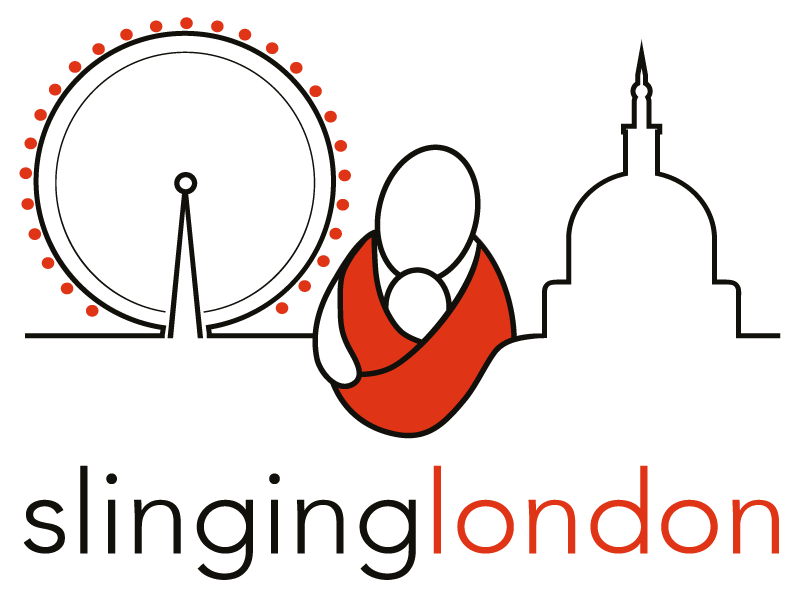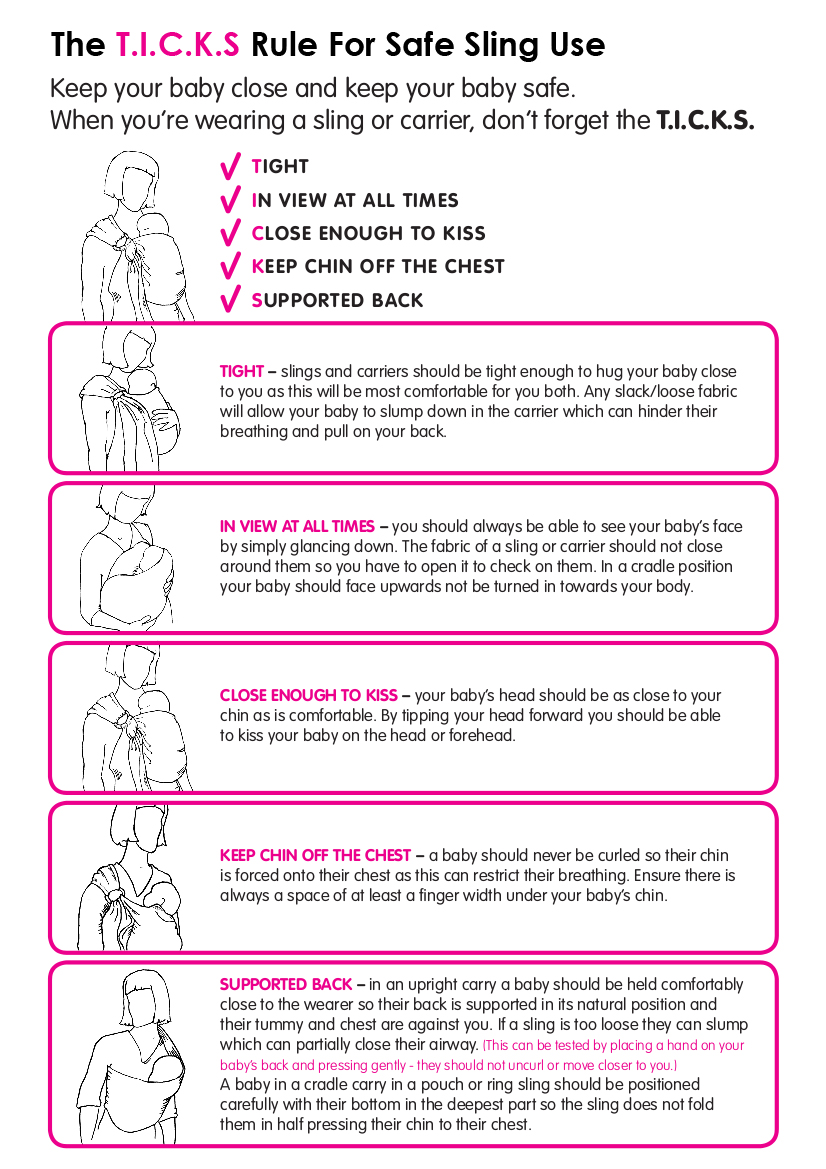When babies and children are involved there is no room for imperfection. As you can imagine there are several aspects to ensuring you and your child are safe when using a sling.
Firstly, the safety of the sling itself. There is a European standard for sling safety (BS EN 13209-2: 2005) that many larger scale manufacturers of slings comply with. Safety testing is often not practical for smaller scale manufacturers and work-at-home makers, so it’s a good idea to check with your local sling library or sling consultant that the company has a good reputation.
Checking for general wear and tear every use is also a good idea. Checking that buckles have no cracks or chips, checking the attachment of straps to the body of the carrier and ensuring there is no fraying or loose threads and checking the material on the carrier or wrap for any snags or holes that could become worse when bearing weight are all key areas to check.
positioning:
Secondly, the safety of your child’s positioning in the sling. There are a few simple things to remember when positioning your child in ANY sling to ensure optimum safety:
Periodic checks are a good habit to get into when using a sling, just as you would with a child in a buggy. Just a quick check on baby’s position at regular intervals will make sure they haven’t slumped down in the sling, causing their chin to rest on their chest which would mean their airway becomes blocked/partially blocked. Being able to fit 2 fingers width underneath baby’s chin means their airway is fully open. Also check that no fabric is covering their face and that they aren’t too hot – testing the skin on the back of their neck is the best place for this as tiny babies almost always have cold hands and feet!
When you start using a sling, whether it be on front, back or hip, you have to get used to your new size! It is pretty much second nature to cuddle the child with our arms even when they are well supported in a sling on our front, so generally they will always have that protection. It is always worth bearing in mind when walking through doors to be extra mindful of your child’s legs, they have a habit of sticking them out at the least opportune moments! When carrying your child on your back remember to allow a little extra space for them, especially turning around in crowded areas or on public transport. Also be mindful when you are shopping, especially when your child is on your back, as they like to try and grab things off shelves and racks!
Newborns do need an extra little protection whilst in a sling. Be mindful when bending forward, their neck has very little strength so you will need to lend a hand. Just taking the weight of your baby’s head in your hand as you bend forward will keep everything safe and supported.
Take care not to overdress your child. The sling is meant to replace one layer of clothing for both you and your child.
in cold weather:
- You can add extra layers to legs and arms, such as leg or arm warmers which are a very handy and inexpensive extra.
- Carrying them in a big thick snow suit is not ideal. It will make securing the sling harder due to the bulky and usually slippery material used on snowsuits, and also it could possibly make your child overheat. Babies and children have an inbuilt mechanism to enable them to regulate their body temperature using ours. The closer they are to our skin, the more they will be able to regulate.
- A useful item to have, especially if carrying your child on your back, is a hat that ties under the chin. A gust of wind could easily whip a hat off and you’d be none the wiser as it rolls down the road behind you!
- You can also put a coat over the both of you, front or back. A regular coat a size or 2 bigger than you would normally wear will zip up over the top of the sling and keep you both snug and warm inside. Of course if you are looking to carry more permanently, you could invest in a specially made ‘sling’ coat which are made with extra panels to fit babies in and/or extra head holes for your child. (Check out The Sling Space if you want to know more!)
- There are risks associated with taking your baby out in snow and ice, whether you transport them in a sling or in a buggy. If you do choose to use a sling in snowy or icy conditions, please bear the following in mind: A well secured sling will keep the child’s centre of gravity close to you and so it will be easier to walk on uncertain ground. Shoes or boots with good grip are always useful in bad weather, but for extra peace of mind while carrying you can buy ice grips that go over your shoes – an inexpensive way to keep steady on the ice.
Another possibility is a clip or tie on sling cover that goes on over the top of your coat. They can be made of fleece or of waterproof material, with or without a hood. They are generally inexpensive and are one size so will last you several years. They are stocked in many sling retail shops, including The Sling Space .
in hot weather:
- Again, the sling replaces one layer of clothing. If you want to carry your child in just a nappy, that’s absolutely fine! Just place a muslin or similar between you to absorb any sweat and to keep the child from slipping against you.
- Be careful to ensure that your child is sufficiently covered in sunscreen, especially legs, arms and face.
- A wide brimmed sun hat is also a brilliant idea! Find one with ties and you won’t lose it while back carrying!
- Keeping extra hydrated is very important for both of you.
- Stick to the shade where possible or use a parasol over the both of you.

